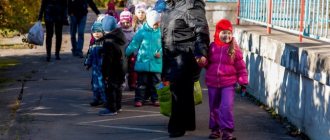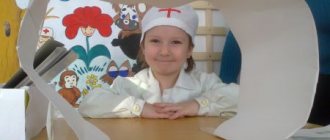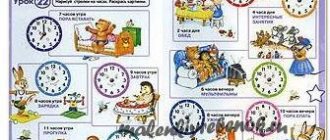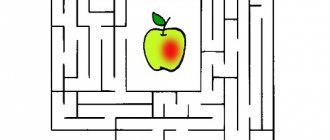Lesson notes for a compensatory preparatory group. Theme "Winter clothes"
Lesson notes for the compensatory preparatory group
Topic
.
Winter clothes. Working on a closed picture Purpose
.
Improve your ability to ask questions correctly. Objectives:
1. Consolidate knowledge on a lexical topic 2. Strengthen the ability to use enumeration intonation 3. Improve the ability to ask questions 4. Improve the skills of writing sentences, telling a story on a topic 5. Develop thinking abilities 6. Develop gross and fine motor skills 7. Develop visual perception
Equipment
: two sets of outerwear, two pairs of mittens of different sizes
Lesson progress
: 1.
Org.
moment: - Guys, I invite you for a walk.
— What time of year is it now? (winter). So, we will have a walk... (winter) 2. Children find themselves in a magical forest
- What do we need in order to go for a walk? (cloth)
- Like ours at the gate, a miracle tree grows. Miracle, miracle, wonderful! Not leaves on it, Not flowers on it, But stockings and shoes, like apples! (there are two sets of winter outerwear on the hanger tree)
3. “
The fourth extra”
(slide 2, 3) - Look, what’s “extra” in the picture?
Explain 4. Distribution of clothing items by season
(slide 4)
— It’s freezing outside in winter. It will freeze your cheeks and nose. What clothes should we wear for a walk?
- In the hottest summer hours - only a T-shirt and shorts. What else do we wear in the summer?
5.
Dressing algorithm
(slide 5)
- What is missing? What else can you call them?
6.
Finger gymnastics
(slide 6)
We put on mittens, (Put on) Mittens, mittens. (Gesture “flashlights”) We ran to the skating rink. (Run) We rode there for an hour. (Sliding) The hands in the mittens are not frozen (Clapping) In the mittens, in the mittens. (Gesture “flashlights”)
- Let's enlarge the mittens - what word will we get? Let's reduce the mittens - what word will we get?
7.
Physical exercise
: “Winter walk” (performing movements following the text) - So, we have already prepared the clothes, now we need to get dressed:
Very cold in winter
(pat yourself on the shoulders)
But we will go for a walk with you.
(steps in place)
I will put on a hat,
(imitate the movement “putting on a hat”)
I will put on a fur coat, (
we show how to put on a fur coat)
I will put on a scarf.
I'll tie it tighter. (“ we tie” a scarf
) And then beautiful, warm, fluffy, (
we show our hands
) Crumbs - I’ll pull the mittens over the hands.
( we stroke the backs of our hands
) And although I am small, (
hands on my belt
) I have felt boots.
( we place our feet one by one on the heel)
I’ll take the sled with me and go up the hill.
( steps in place)
I’ll go up the hill (
raise my arms up
) And I’ll ride down the hill!
Woohoo! ( quick movement of hands down)
8. Working on a painting
(slide 7) - What is shown in the center? - Who could be there? (Children ask questions that can only be answered “yes” or “no”) - In what? (blue and yellow hat, blue and yellow jacket, yellow and red scarf, blue mittens, green pants, orange felt boots) (slide - Let's make a story, what happened? (Winter has come. The guys made a high slide in the yard. Petya dressed warmly , took a sled and began to ride down the hill. It’s good in winter!) (slide 9) 9.
- Who could be there? (Children ask questions that can only be answered “yes” or “no”) - In what? (blue and yellow hat, blue and yellow jacket, yellow and red scarf, blue mittens, green pants, orange felt boots) (slide - Let's make a story, what happened? (Winter has come. The guys made a high slide in the yard. Petya dressed warmly , took a sled and began to ride down the hill. It’s good in winter!) (slide 9) 9.
Watching an excerpt from “Jumble”
(“Seryoga, come out!”) 10.
Dressing competition
- Now let’s see if there are any such “earrings” among us "We have two sets of winter clothes on the magic tree. We invite the owners. Show how quickly you can dress 11.
Winter walk PPT / 4.75 Mb
How to teach a child to put on pants?
It is best for a child to learn this while sitting on a chair or on the floor. Then the baby will be able to put on trousers while standing - but this is the next stage.
Show your child that he has two legs. And the trousers have two “windows”. Tell them the secret: “Every foot has its own window.” This couplet is very well remembered by children. Remind them of this phrase before putting on trousers, and they will learn to put them on without any problems and will never put two legs in one trouser leg.
There is another problem in putting on trousers - very often the child’s foot gets stuck in one place of the trousers and “does not go further”. Especially if the trousers are very tight, they are uncomfortable to wear.
What to do? Show your baby how to sit. How to take a trouser leg (fold it into pleats) and how to insert your leg into the trouser leg. Show yourself using your clothes as an example. In the first attempts at dressing, guide the child’s hands if necessary (the “hand in hand” technique - that is, you hold the child’s hands and guide them).
What to do if your child takes too long to get dressed for a walk?
Firstly, the baby will always take longer to dress himself than if we were to dress him. He's still studying.
Secondly, if the process of getting dressed for a walk is clearly delayed, then it is best to remind your child that interesting things await you outside (we will sculpt a big snow woman, play snowballs, ride a bike, etc.).
Thirdly, if you see that the baby is puffing for a long time, sticking out his tongue from tension, trying to do something on his own for a long time, but he is not succeeding, then it is natural that you need to help him, and not fundamentally insist on independence. Let me remind you that dressing is a difficult process for a child, in which he really needs the support of adults, our love and patience. And here you need to find a middle ground - what the child does on his own, and what he needs your help with for now, since getting dressed for a walk completely independently is not yet possible for him.
How to teach a child to dress in the correct order?
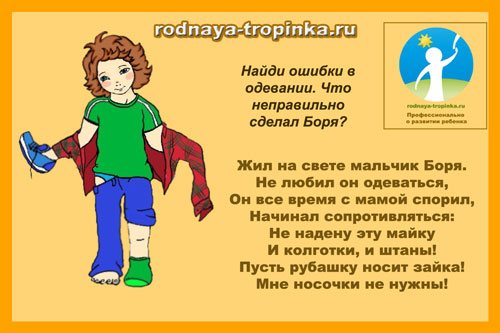
Very often children get confused about what to wear and what to wear. They can put on their shoes first, and already having put them on remember that they should have put on socks before. Or put on a jacket first, and already having put it on remember that there should be a blouse under the jacket.
To keep your baby from getting confused, you need to make a small “cheat sheet in pictures” for him. This will be our dressing sequence model. You can use such models available on the Internet or make your own - a family one, which is always especially loved by children.
Making such a model is a very simple algorithm. We take a camera or mobile phone and photograph the baby’s clothes on a white background (a piece of whatman paper). Then, in any photo processing program, we reduce the size of the photos and arrange them in the desired sequence. We print and post.
When we get ready to go outside, we look at our picture - what we need to wear next. Let your child prompt you first, and then he himself will be able to use such a scheme. This pattern not only teaches how to dress, but also develops children’s visual and imaginative thinking and teaches them to “read” the simplest patterns. Then you can replace the pictures with your pictogram drawings.
Another version of the scheme. We find clothing coloring pages online and print them out. We select the pictures we need in accordance with your baby’s clothes. We color them together with the child, or even with the whole family. Glue them in the required sequence onto the cardboard. The scheme is ready.
Very important:
The dressing sequence diagram at home and in kindergarten should not hang at the eye level of adults, but at the child’s eye level! If this is not possible, make it mobile (for example, attach individual pictures in the desired sequence using UHU patafix to the door at the child’s eye level). It will always be possible to remove and replace an unsuitable picture, and there will be no traces of our attaching the picture to the wall or door. In any case, always hang the picture in the same place so that the baby gets used to it and knows where it is and refers to it himself.
At first, you and your baby will have to frequently refer to the picture together. Then - just to check if everything is correct and to correct mistakes in dressing for a walk. Then the diagram will no longer be needed, the baby will remember the dressing sequence, and the diagram - picture can be removed.
When your baby grows up, you can begin to teach him to determine for himself how best to dress for a walk. To do this, you can play the game “Forest Radio”. You will need a toy microphone or a substitute microphone and toys - animals. And also pictures of different clothes.
Progress of the game. The forest radio (the role of the announcer in the first games is played by an adult) announces the weather forecast, and the child needs to explain to the forest kids how to get ready for a walk, what clothes to wear. To do this, he needs to select suitable pictures of clothes and shoes and arrange them in the order of dressing. For example, if it rains, then felt boots or sandals will not suit us, but we need rubber boots or shoes. We also need a raincoat or jacket with a hood.
Dressing and playing, or how to dress is interesting.
Dressing is a very tedious and difficult process for a child. Therefore, it is best to turn it into an interesting game.
- Little engine. The pant leg or sleeve is a tunnel. Our leg or hand enters it - this is a train.
- Each leg has its own window (putting on panties). Or “each leg in its own house” (putting on tights)
- Hide and seek. You can play hide and seek not only with a collar, as described above. But hands can be hidden in mittens, feet in socks.
- Green or red? Reception of choice. At about 3 years old, children go through the 3-year-old crisis, and many parents have a problem in the morning - the baby refuses to put on clothes, cries, and is capricious. What to do? The choice technique will help: “Which T-shirt will you wear today – red or yellow?” or “What will you wear first – a skirt or a blouse?” As soon as the baby gets the right to choose, the critical situation disappears. For older children, you can discuss and select clothes for tomorrow with your child in advance.
- Children really like it when poetry is used when dressing for a walk. You will find them in the article “Poems for Little Ones” (see “Poems for Dressing Up”) and at the end of this article.
- Always praise your child for what he has achieved. For example, a girl put on a blouse. But she fastened the buttons incorrectly - she missed two loops. As a result, the jacket is worn “on one side” and the situation needs to be corrected. Here you cannot scold and the mother herself can fix everything. Or simply say: “Well done!”, ignoring the mistake. You need to name specifically what has already happened and praise it from the bottom of your heart: “Katyusha!” Good girl! You have already learned how to thread your arms into the sleeves yourself. How wonderful you did! And how fast! ” and immediately set a new task: “Let’s also try to learn how to fasten buttons correctly. You see, your hole is missing. And here's another one. Let's try to do it right together - let's send every button to live in its own house. Where is this button’s house?”
- If the baby mixes up the face and the back of the thing, then say: “Where did our bear hide? (the bear is embroidered on the pocket). Let's look for it together. Here he is! We need to see the bear. Let's turn the trousers inside out so that the bear can be seen. Like this! Now put on your pants. What skillful hands you have!”
